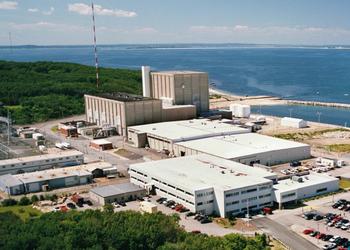
WASHINGTON, DC, April 18, 2014 (ENS) – Massachusetts Senators Edward Markey and Elizabeth Warren today called on the Nuclear Regulatory Commission to direct the licensees of Pilgrim Nuclear Power Station in Massachusetts and Seabrook Station in New Hampshire to immediately implement mitigation measures against seismic risks that were previously unknown.
Reports released Thursday by the NRC reveal that dozens of reactors that reassessed their vulnerability to earthquakes in the wake of the March 2011 meltdowns at Japan’s Fukushima Daiichi nuclear plant are at greater risk than they were originally licensed to withstand.

“We were alarmed to discover that of the dozens of reactors that re-assessed their vulnerability to earthquakes in the wake of the Fukushima meltdowns, the newly evaluated seismic risk at both Pilgrim and Seabrook is larger than the risk the reactors were originally licensed to withstand,” write the Senators in the letter to NRC Chair Allison Macfarlane.
On March 31, 2014, licensees of all reactors in the continental and eastern U.S. submitted these seismic hazard re-evaluations to the NRC.
These submittals indicate that for both Pilgrim’s and Seabrook’s reactors and spent fuel pools, the new earthquake hazard is greater than the so-called “safe shutdown earthquake”, which is defined to be “the maximum earthquake potential for which certain structures, systems, and components, important to safety, are designed to sustain and remain functional.”
The two million watt Pilgrim nuclear power plant, operated by Entergy, is located 38 miles southeast of Boston, Massachusetts. The updated seismic data shows that Pilgrim could feel the effects of earthquakes as far away as 400 miles, double the previously estimated distance.
Seabrook is located 13 miles south of Portsmouth, New Hampshire, 56 miles north of Boston. It generates 1.2 million watts of electricity, enough to supply the annual needs of 1.2 million families.
The licensee is NextEra Energy Seabrook, LLC. The NRC report asks NextEra to ensure that the supplemental emergency power supply for diesel generators is robust enough to provide “sufficient protection of the equipment from seismic events and wind-driven missiles.”
“We urge you in the strongest possible terms to direct the licensees of the Pilgrim Nuclear Power Station and the Seabrook Station to immediately take all necessary measures to assure the safety of the reactors and those that live and work near them,” write Senators Markey and Warren to the NRC chair.
One of the recommendations of the NRC’s Near Term Task Force report following Fukushima was that licensees re-evaluate seismic hazards at each reactor using current research and models in order to develop a better understanding of possible earthquake hazards at the site and determine whether additional safety measures are needed.
Licensees of all reactors in the continental and eastern U.S. submitted these seismic hazard re-evaluations to the NRC in March.
Now the licensees of several dozen reactors must analyze their structures and components for earthquake risk at an estimated cost of roughly $5 million for each analysis.
Two industry experts told the “New York Times” earlier this month that across the central and eastern United States, plants at 24 sites reported that the new earthquake threat was larger than what they were designed to face. The commission has not released a total yet.
It is known that further study and possible upgrades to strengthen earthquake preparedness will required of: Beaver Valley 1 and 2, Indian Point 2 and 3, Peach Bottom 2 and 3, Pilgrim Nuclear Power Station, Seabrook Nuclear Power Plant and Three Mile Island.
“The additional analysis will look at whether existing plant structures and systems could withstand the greater ground movement,” NRC spokesman Neil Sheehan told reporters. “They are expected to take at least three years to complete and will be used to determine if upgrades are needed to plant equipment, systems and structures.”
“Notably,” the senators wrote the NRC chief, “The new seismic hazard was found to exceed the safe shutdown earthquake at the ground shaking frequencies that are most likely to threaten the equipment needed to safely shut down the reactor.”
Senators Markey and Warren are especially concerned about Entergy’s March 10 request to the NRC asking for permission to alter some of the numbers used to model the geologic properties of the bedrock on which the Pilgrim nuclear plant sits to “prevent unjustified alarm by stakeholders when GMRS [ground motion response spectrum] results are made public.”
“While this request was not expected to remove the requirement for Pilgrim to perform additional analysis and/or implement mitigating measures, Entergy’s submittal stated that using these numbers would cause the results to be less alarming,” the senators write.
Licensees are given until 2017 to complete their analyses, but the Massachusetts senators are asking the Nuclear Regulatory Commission to direct Entergy not to wait that long but to require the company to “more quickly implement mitigating measures for the reactor equipment that would be needed to safely shut down the reactors in the event of an earthquake.”
“NRC has already required the implementation of such measures for some reactors that found a higher than expected floodiing hazard,” they point out.
“We urge you in the strongest possible terms to direct the licensees of the Pilgrim Nuclear power Station and the Seabrook Station to immediately take all necessary measures to assure the safety of the reactors and those that live and work near them,” and provide a response no later than close of business on Friday May 9, 2014.
Copyright Environment News Service (ENS) 2014. All rights reserved.
